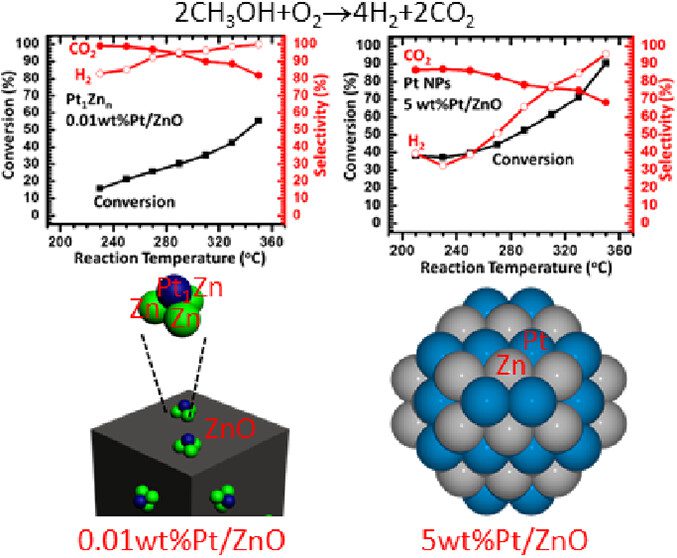
We have synthesized Pt1Zn3/ZnO, also termed 0.01 wt %Pt/ZnO-O2–H2, as a catalyst containing singly dispersed single-atom bimetallic sites, also called a catalyst of singly dispersed bimetallic sites or a catalyst of isolated single-atom bimetallic sites. Its catalytic activity in partial oxidation of methanol to hydrogen at 290 °C is found to be 2–3 orders of magnitude higher than that of Pt–Zn bimetallic nanoparticles supported on ZnO, 5.0 wt %Pt/ZnO-N2–H2. Selectivity for H2 on Pt1Zn3/ZnO reaches 96%–100% at 290–330 °C, arising from the uniform coordination environment of single-atom Pt1 in singly dispersed single-atom bimetallic sites, Pt1Zn3 on 0.01 wt %Pt/ZnO-O2–H2, which is sharply different from various coordination environments of Pt atoms in coexisting PtxZny (x ≥ 0, y ≥ 0) sites on Pt–Zn bimetallic nanoparticles. Computational simulations attribute the extraordinary catalytic performance of Pt1Zn3/ZnO to the stronger adsorption of methanol and the lower activation barriers in O–H dissociation of CH3OH, C–H dissociations of CH2O to CO, and coupling of intermediate CO with atomic oxygen to form CO2 on Pt1Zn3/ZnO as compared to those on Pt–Zn bimetallic nanoparticles. It demonstrates that anchoring uniform, isolated single-atom bimetallic sites, also called singly dispersed bimetallic sites on a nonmetallic support can create new catalysts for certain types of reactions with much higher activity and selectivity in contrast to bimetallic nanoparticle catalysts with coexisting, various metallic sites MxAy (x ≥ 0, y ≥ 0). As these single-atom bimetallic sites are cationic and anchored on a nonmetallic support, the catalyst of singly dispersed single-atom bimetallic sites is different from a single-atom alloy nanoparticle catalyst. The critical role of the 0.01 wt %Pt in the extraordinary catalytic performance calls on fundamental studies of the profound role of a trace amount of a metal in heterogeneous catalysis.
This work was published in ACS Applied Materials & Interfaces.
[T. Jiang, Y. Li, Y. Tang, S. Zhang, D. Le, T. S. Rahman, F. Tao, “Breaking Continuously Packed Bimetallic Sites to Singly Dispersed on Nonmetallic Support for Efficient Hydrogen Production.” ACS Appl. Mater. Interfaces, 16, 21757 (2024). https://doi.org/10.1021/acsami.3c18160]